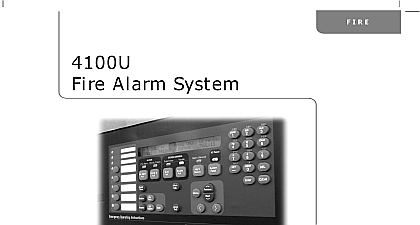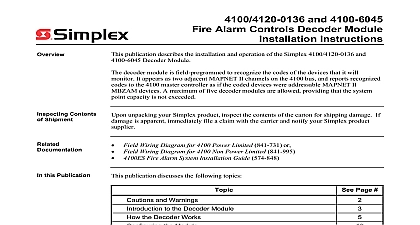Simplex Glossary of Fire Alarm Terms Reference Manual

File Preview
Click below to download for free
Click below to download for free
File Data
| Name | simplex-glossary-of-fire-alarm-terms-reference-manual-7469381025.pdf |
|---|---|
| Type | |
| Size | 707.37 KB |
| Downloads |
Text Preview
Glossary of Fire Alarm Manual 2000 Simplex Time Recorder Co specifications and other information shown were current as of publication and are subject to change without notice 575 301 A ALARM TERMS Control Device A fire alarm system output device that when operating with a compatible control is used to turn on or off individual preselected electrical circuits such as audible or visible alarm notification fan circuits door release circuits etc Initiating Device A fire alarm system data input device that when communicating with a control unit can have its status individually identified by the control unit Notification Appliance Any audible or visible signal used to indicate a fire condition Initiating Device Automatic Devices that automatically respond to a fire condition and operate alarm by means of an electrical circuit Initiating Device Manual A fire alarm box which will by means of an electrical circuit cause alarm signals be operated Signal General A signal indicating an emergency which requires immediate attention Verification Feature A feature of automatic fire detection and alarm systems that reduces unwanted For an alarm to be accepted as a valid initiation signal this feature requires that automatic smoke detectors alarm conditions for a minimum period of time or confirm alarm conditions within a given period of time after reset Initiating Device Sensor An initiating device that when used with a compatible control unit transmits signal that permits a system to measure how much of exists at the initiating device location as with the conventional initiating device which can only indicate an signal Uses for analog initiating in a fire alarm signaling system include measuring smoke density obscuration temperature water level pressure An electrically or mechanically operated signaling device having one or more target or lamp to display the status of the fire alarm system Annunciators can be installed as an integral part of an alarm control unit or can be located remotely wherever they can be most readily consulted upon the sounding of alarm signal In manual alarm systems they can also be isolated electrically from the control cabinet and directly by special annunciator contacts included within the various alarm initiating devices Annunciators are used frequently with noncoded or zoned systems since coded systems achieve annunciation with the audible code indicates the origin of any alarm signal Annunciators are of two general types drop type which drops or a flag into view behind a small window and lamp type which turns on a light Device This term applies to any noise making device used to indicate trouble or an emergency It bells gongs chimes buzzers horns sirens howlers and trumpets Fire Alarm System One in which an alarm initiating device operates automatically to transmit or an alarm signal System Any system which is connected to a municipal master box The tripping of the master box a coded signal to the central fire station over an independent municipally owned and operated fire alarm Fire Alarm Protective Signaling System A system which is connected through a municipal fire box to municipal fire headquarters Operation of the system actuates the master municipal box either directly by means of an auxiliary trip relay thereby transmitting a coded alarm to the central fire station over a municipally and operated community fire reporting system See definition of this term under its alphabetical listing Trip Relay A relay used to operate a municipal master box from an auxiliarized control panel On local master box systems the relay must also be supervised or monitored and the tripping current taken from a supervised source of current located on the premises protected On these systems the trip coil of the L E box must be supervised Electromechanical A device whose striking power is derived from a clock spring mechanism and whose is controlled by an electrical impulse Single Stroke A device whose gong is struck only once each time operating energy is applied to the bell Vibrating A device which rings continuously as long as operating power is applied to the bell or Station Fire Alarm Coded Similar to the noncoded type except that instead of a manually operated a mechanism to rotate a code wheel is utilized which in turn causes the electrical circuit to be alternately and closed or closed and opened thus sounding a coded alarm which identifies the location of the box The wheel is cut for the individual code to be transmitted by the device and may operate by clockwork or an electric Clockwork transmitters may be prewound or may be wound by the pulling of the alarm lever The box is designed to repeat its code four times and automatically come to rest Prewound transmitters must sound a signal when they require rewinding or Station Noncoded Fire alarm boxes are essentially manually operated switches housed in distinctive enclosures Various types are available Generally these boxes are of the maintained contact type once the is closed contact is maintained until some specific external action restores the unit to normal This action is in the form of resetting with a special key supplied with the box Various contact and circuit arrangements available to perform several functions simultaneously Boxes are available in surface flush and semiflush with or without a break glass feature Boxes of the two action type have a door which must be held open the lever or handle is pulled downward This adjective applied to fire alarm boxes means that a glass must be broken before or with the sounding of an alarm The break glass feature serves as a psychological barrier against alarms and its inclusion is not normally required by law being largely a matter of customer preference Break boxes are called action when as is today most common the single action of pulling a lever breaks a rod placed against it and sounds an alarm They are called action when they contain a window which be broken with an attached hammer or other external tool before the alarm lever can be pulled A vibrating reed device in which an armature is continuously vibrated as long as operating power is The vibrating reed or armature usually is adjusted to strike the magnet core or the housing of the device to tone output Fire Station The main building location that houses the central station system and to which all master transmit their code when activated Station Fire Alarm Protective Signaling System A system in which an alarm signal is transmitted private or leased wires to the central office of a private company whose primary business is supervising a of buildings which may be scattered throughout a community This central office is continually manned by personnel who take immediate appropriate action upon receipt of an alarm signal Single strike or vibrating audible notification appliances having a xylophone type stroking bar They a pleasing tone and are often used in presignal fire alarm systems as a prewarning device at strategic without disturbing the general building occupants Interface A functional assembly that interfaces one or more initiating device circuits or notification circuits with a signaling line circuit so that the central supervising station can indicate the status of each its initiating device circuits or notification appliance circuits Local Energy Control Used with local energy master box The current for tripping and supervising the box coil is taken from the same source as for the operating supply of the local fire alarm control See definition of this term under its alphabetical listing Transmitter An automatic fire alarm transmitter is a coded alarm initiating device arranged for automatic by one or more of the following means 1 by an electrical impulse from an automatic detecting device or manual fire alarm box 2 by direct action of a manual tripping lever or 3 by mechanical linkage to a waterflow pressure actuated detecting device Code transmitters may be spring wound or motor driven They may sound signals or alarm and trouble signals Some transmitters send signals when reset after an alarm Alarm Signal A series of audible beats representing a number to indicate the location of the fire alarm o


